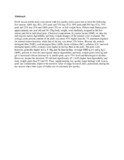| dc.description.abstract | Fresh Acacia tortilis pods were mixed with low quality native grass hay to form the following
five rations: 100% hay (T1), 25% pods and 75% hay (T2), 50% pods and 50% hay (T3), 75%
pods and 25% hay (T4) and 100% pods (T5) on ‘as fed' weight basis. Fifteen male Barka goats,
approximately one year old and 10–15kg body weight, were randomly assigned to the five
rations and fed in individual pens. Chemical composition, dry matter intake (DMI), in vitro dry
and organic matter digestibility and body weight changes of the animals were evaluated. The
average crude protein content of the pods was about 47% higher than the 7% minimum required
for normal rumen function, while that of the hay was about 13% below. Percent ash, neutral
detergent fibre (NDF), acid detergent fibre (ADF), hemi-cellulose (HC), cellulose (CL) and acid
detergent lignin (ADL) contents were higher in the hay than in the pods. The pods were,
however, generally higher in Ca, P, Mg and Na than the hay. Average DMI (g d-1 and g kg-1
LBW), percent in vitro dry and organic matter digestibility and body weight gains (total kg and
gd-1) increased with an increase in A. tortilis pods, up to 75% level and then begun to decline.
However, despite the decrease, T5 still had significantly (P < 0.05) higher feed digestibility and
body weight gains than T2 and T3. Thus, supplementing low quality range herbage with Acacia
pods can considerably improve the nutritive value of range livestock diets, particularly during the
dry season when other types of fodder are of extremely low quality. | en_US |

